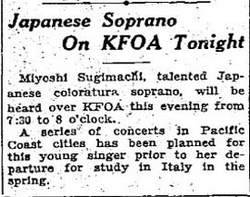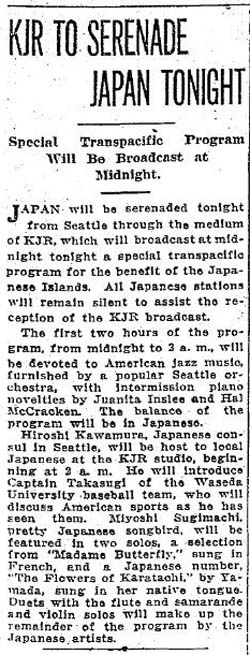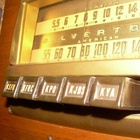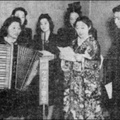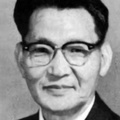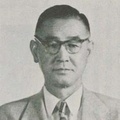The activities of Japanese musicians
Before the Japanese language programs began, there were Japanese musicians who were active on American radio broadcasts. As early as March 1922, a Hawaiian newspaper reported that soprano singer Tamaki Miura, who was performing in Seattle as a member of the San Carlo Opera Company, had made a radio appearance.
There are no reports in the local Seattle newspapers, so the veracity of this story is unknown. What is certain is that Miyoshi Natori, a vocalist known as the "soprano born in Seattle," frequently sang for KFOA as a resident singer from 1924 onwards.
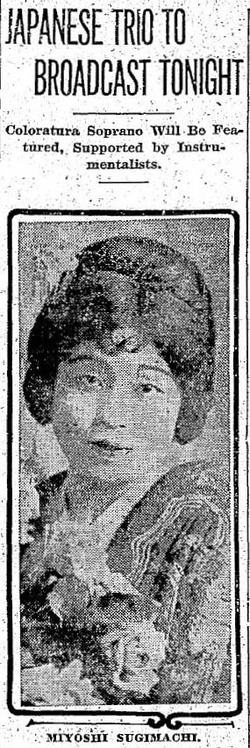
Natori Miyoshi married Sugimachi Yaemitsu, a reporter for the North American Newspaper, and adopted the surname Sugimachi, becoming widely known as Madame Sugimachi. KFOA was a radio station operated by the Rhodes Department Store, located on the corner of Union Street and 2nd Avenue in downtown, and opened in March 1924 with a studio on the fourth floor of the store. The station organized a number of programs that focused on Japanese musicians, including Uesugi Sada (violin, appeared in 1924), Fujiwara Yoshie (tenor, appeared in 1925), Sato Tokitaro (harmonica, appeared in 1928), and Agnes Miyagawa (soprano, appeared in 1928).
In November 1925, a live broadcast of the Meiji-Shinshu reception hosted by Acting Consul Miyazaki Shinro at the Olympic Hotel was aired, featuring performances of Japanese and American songs and greetings from Acting Consul Miyazaki and Japan Society President Shank. In 1927, a Japanese music program entitled "Japanese Program" was aired several times, featuring Sugimachi Miyoshi and others.
In addition to KFOA, there are records of Kurihara Hanae (soprano, appeared in 1927), Elizabeth Suzumebe Toyoko (soprano, appeared in 1928), and Sakano Jiro (baritone, appeared in 1929) appearing on KOMO and KOL stations.
KJR test broadcasts to Japan
In the early 1920s, when radio broadcasting first began, it was not clear how far radio waves could reach. Eventually, it became clear that radio waves could reach farther than expected, for example, broadcasts from Seattle could be heard on the East Coast. This raised the question of whether radio signals could be received in Europe, and test broadcasts were repeatedly made from the East Coast, confirming that radio signals could be received long distances across the Atlantic.
The next target was attempts to transmit radio waves across the Pacific Ocean. The most famous attempt, made in August and November 1924 by KGO station in Oakland, California, was a great success, with its signal being received as far away as Japan.
Motivated by this trend, Seattle's KJR station also planned a test broadcast to Japan. Taking advantage of the opportunity when the transmitter's output was increased to 1kW, test broadcasts were made at 1:30 am on January 27, 1925, and 10 pm on February 17. Although the station waited to receive the signal at the Electrical Testing Laboratory branch in Hiraiso, Ibaraki Prefecture, it was not possible to catch it.
After installing the 5kW transmitter, KJR conducted another test broadcast for four hours from midnight on June 12, 1927. The broadcast was divided into two parts. The first part featured jazz and novelty piano performances by KJR's regular performers. The second part, which began at 2:00 a.m., featured a special Japanese program. The contents were arranged by the North American Jijisha and the Seattle Japan Society (now the Japan-America Society of Washington State) with the cooperation of the Japanese Consulate. The broadcast included greetings from Consul Kawamura Hiroshi and the Japan Society's president, Sakurauchi Atsuya (head of the Seattle branch of the Yokohama Specie Bank), a talk on American sports by Professor Takasugi Takizo, who was the leader of the Waseda University baseball team on its US tour, and songs such as "Madame Butterfly" and "Karatachi no Hana" by Sugimachi Miyoshi. This was Seattle's first Japanese broadcast.
The Seattle Daily Times reported this test broadcast as "A special program heard in Japan," but Japanese-language newspapers cited information from the consulate that "the broadcast could not be received in Tokyo due to interference from atmospheric electricity" (Daihoku Nippo, June 13, 1927). Long-distance reception of medium wave broadcasts is unstable, and it appears that the signal conditions on the day just happened to be poor, but we would like to add that on a later occasion, KJR's signal was confirmed to be received in Japan.
Next time, we will cover the Japan Music Broadcasting program, which was sponsored by Nakamura Watch Shop.
*This article is an excerpt from Japan Hour (2020) and reprinted from North American Newspaper (November 19, 2021).
© 2020 Tetsuya Hirahara


